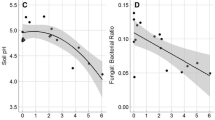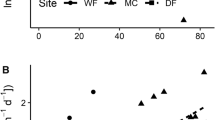Abstract
The introduction of exotic plants can have large impacts on ecosystem functions such as soil nutrient cycling. Since these impacts result from differences in traits between the exotic and resident species, novel physiological traits such as N cycling may cause large alterations in ecosystem function. It is unclear, however, whether all members of a given functional group will have the same ecosystem effects. Here we look at a within functional group comparison to test whether an annual (Lupinus luteus) and a perennial (Acacia saligna) N-fixing exotic species cause the same effects on soil N cycling in the fynbos vegetation of South Africa. We measured litterfall quantity and quality, and soil total nitrogen and organic matter for each vegetation type as well. Available nitrogen was quantified using ion exchange resin bags monthly for 1 year. We used microcosms to evaluate litter decomposition. Although both exotic species increased the available nitrogen in the soil, only Acacia increased the total soil N and organic matter. This could be explained by the slow decomposition of Acacia litter in the microcosm study, despite the fact that Acacia and Lupinus litter contained equivalent N concentrations. Presumably, low carbon quality of Acacia litter slows its decomposition in soil, resulting in retention of organic nitrogen in Acacia stands after clearing for restoration purposes. The differences in long term impacts of these annual and perennial species highlight the fact that not all N-fixing exotic species exert equivalent impacts. Ecologists should consider multiple traits rather than broadly defined functional groups alone when predicting invader impacts.
Similar content being viewed by others
References
Callaway RM, Thelen GC, Rodriguez A and Holben WE (2004). Soil biota and exotic plant invasion. Nature 427: 731–733
(1993). Functional role of growth forms in ecosystem and global processes. In: Ehleringer, JR and Field, CB (eds) Scaling Physiological Processes: Leaf to Globe, pp 287–312. Academic Press, San Diego, CA
Chapin FS III, Reynolds HL, D’Antonio CM and Eckhart VM (1994) The functional role of species in terrestrial ecosystems. In: Walker B and Steffen W (eds) International Geosphere–Biosphere Programme Book Series, Vol. 2: Global Change and Terrestrial Ecosystems, pp 403–428. Cambridge University Press
Corbin JD and D’Antonio CM (2004). Effects of exotic species on soil nitrogen cycling: implications for restoration. Weed Technology 18: 1464–1467
Craine JM, Tilman D, Wedin D, Reich P, Tjoelker M and Knops J (2002). Functional traits, productivity and effects on nitrogen cycling of 33 grassland species. Functional Ecology 16: 563–574
D’Antonio CM and Vitousek PM (1992). Biological invasions by exotic grasses, the grass fire cycle and global change. Annual Review of Ecology and Systematics 23: 63–87
Ehrenfeld JG (2003). Effects of exotic plant invasions on soil nutrient cycling processes. Ecosystems 6: 503–523
Evans RD, Rimer R, Sperry L and Belnap J (2001). Exotic plant invasion alters nitrogen dynamics in an arid grassland. Ecological Applications 11: 1301–1310
Eviner VT (2004). Plant traits that influence ecosystem processes vary independently among species. Ecology 85: 2215–2229
Eviner VT and Chapin FS (2003). Functional matrix: a conceptual framework for predicting multiple plant effects on ecosystem processes. Annual Review of Ecology Evolution and Systematics 34: 455–485
Gill RA and Burke IC (1999). Ecosystem consequences of plant life form changes at three sites in the Semiarid United States. Oecologia 121: 551–563
Hättenschwiler S and Vitousek PM (2000). The role of polyphenols in terrestrial ecosystem nutrient cycling. Trends in Ecology and Evolution 15: 238–243
Haubensak KA and Parker IM (2004). Soil changes accompanying invasion of the exotic shrub Cytisus scoparius in glacial outwash prairies of western Washington (USA). Plant Ecology 175: 71–79
Hooper DU and Vitousek PM (1998). Effects of plant composition and diversity on nutrient cycling. Ecological Monographs 68: 121–149
Knops JMH, Bradley KL and Wedin DA (2002). Mechanisms of plant species impacts on ecosystem nitrogen cycling. Ecology Letters 5: 454–466
Lamb AJ and Klaussner E (1988). Response of the fynbos shrubs Protea repens and Erica plukenetii to low-levels of nitrogen and phosphorus applications. South African Journal of Botany 54: 558–564
Le Maitre DC, Chapman RA and Mckelly DH (1996). Invasive plants and water resources in the Western Cape province, South Africa: modeling the consequences of␣a lack of management. Journal of Applied Ecology 33: 161–172
Maron JL and Conners PG (1996). A native nitrogen-fixing shrub facilitates weed invasion. Oecologia 105: 302–312
Maron JL and Jefferies RL (1999). Bush lupine mortality, altered resource availability and alternative stable states. Ecology 80: 443–454
Melillo JM, Aber JD and Muratore JF (1982). Nitrogen and lignin control of hardwood leaf litter decomposition dynamics. Ecology 63: 621–626
Moll EJ, Campbell BM, Cowling RM, Bossi L, Jarman ML and Boucher C (1984) A description of the major vegetation categories in and adjacent to the fynbos biome. South African National Scientific Programmes Report No. 83. CSIR, Pretoria, South Africa
Pickart AJ, Miller LM and Duebendorfer TE (1998). Yellow bush lupine invasion in northern California coastal dunes – I. Ecological impacts and manual restoration techniques. Restoration Ecology 6: 59–68
Rowell DL (1994) Air in soils – supply and demand. In: Soil Science: Methods and Applications. Longman Scientific and Technical, Essex, pp 109–129
Scott NA, Saggar S and McIntosh PD (2001). Biogeochemical impact of Hieracium invasion in New Zealand’s grazed tussock grasslands: sustainability implications. Ecological Applications 11: 1311–1322
Stock WD and Lewis OAM (1986). Atmospheric input of nitrogen to a coastal fynbos ecosystem of the Southwestern Cape province, South Africa. South African Journal of Botany 52: 273–276
Stock WD and Lewis OAM (1984). Uptake and assimilation of nitrate and ammonium by an evergreen fynbos shrub species Protea repens L (Proteaceae). New Phytologist 97: 261–268
Stock WD, Wienand KT and Baker AC (1995). Impacts of invading N2-fixing Acacia species on patterns of nutrient cycling in two Cape ecosystems: evidence from soil incubation studies and 15N natural abundance values. Oecologia 101: 375–382
van Wilgen BW, Le Maitre DC and Cowling RM (1998). Ecosystem services, efficiency, sustainability and equity: South Africa’s Working for Water Programme. Trends in Ecology and Evolution 13: 378
Vinton MA and Burke IC (1995). Interactions between individual plant species and soil nutrient status in shortgrass steppe. Ecology 76: 1116–1133
Vitousek PM, D’Antonio CM, Loope LL, Rejmanek M and Westbrooks R (1997). Introduced species: a significant component of human-caused global change. New Zealand Journal of Ecology 21: 1–16
Vitousek PM and Walker LR (1989). Biological invasion by Myrica faya in Hawaii: plant demography, nitrogen fixation, ecosystem effects. Ecological Monographs 59: 247–265
Wardle DA, Barker GM, Bonner KI and Nicholson KS (1998). Can comparative approaches based on plant ecophysiological traits predict the nature of biotic interactions and individual plant species effects. Journal of Ecology 86: 405–420
Wardle DA, Yeates GW, Williamson W and Bonner KI (2003). The response of a three trophic level soil food web to the identity and diversity of plant species and functional groups. Oikos 102: 45–56
Wedin DA and Tilman D (1990). Species effects on nitrogen cycling: a test with perennial grasses. Oecologia 84: 433–441
Williamson M and Fitter A (1996). The varying success of invaders. Ecology 77: 1661–1666
Witkowski ETF and Mitchell DT (1987). Variations in soil phosphorus in the fynbos biome, South Africa. Journal of Ecology 75: 1159–1171
Witkowski ETF (1989). Effects of nutrients on the distribution of dry mass, nitrogen and phosphorus in seedlings of Protea repens (L) L (Proteaceae). New Phytologist 112: 81–487
Witkowski ETF (1991). Effects of invasive alien acacias on nutrient cycling in the coastal lowlands of the Cape fynbos. Journal of Applied Ecology 28: 1–15
Witkowski ETF, Mitchell DT and Stock WD (1990). Response of a Cape fynbos ecosystem to nutrient additions – shoot growth and nutrient contents of a proteoid (Leucospermum parile) and an ericoid (Phylica cephalantha) evergreen shrub. Acta Oecologica-International Journal of Ecology 11: 311–326
Yelenik SG, Stock WD and Richardson DM (2004). Ecosystem level impacts of invasive Acacia saligna in the South African fynbos. Restoration Ecology 12: 44–51
Author information
Authors and Affiliations
Corresponding author
Rights and permissions
About this article
Cite this article
Yelenik, S.G., Stock, W.D. & Richardson, D.M. Functional Group Identity Does not Predict Invader Impacts: Differential Effects of Nitrogen-fixing Exotic Plants on Ecosystem Function. Biol Invasions 9, 117–125 (2007). https://doi.org/10.1007/s10530-006-0008-3
Received:
Accepted:
Published:
Issue Date:
DOI: https://doi.org/10.1007/s10530-006-0008-3




